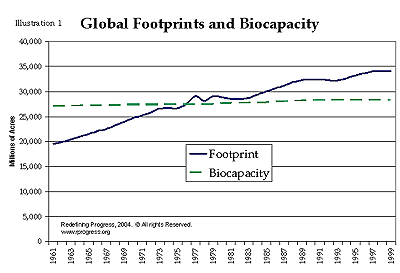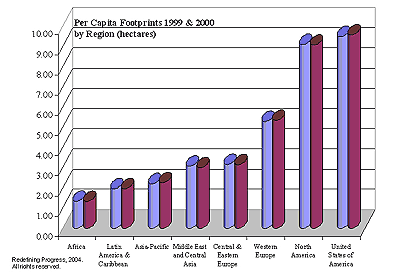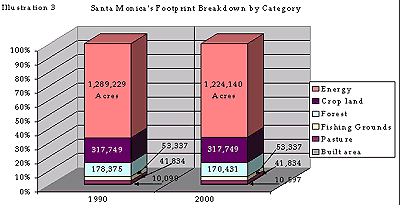by Jason Venetoulis
In order to live, people consume natural resources. This isn’t bad if our use of resources stays within the earth’s capacity to renew and regenerate indefinitely. Are we taking more than we should? In the Living Planet Reports 2000 and 2002, WWF International and Redefining Progress documented that humanity’s Ecological Footprint has breached the limits of environmental sustainability by 15%.
The updated 2004 Footprint of Nations released in March concludes the situation remains unchanged except that the United States has become the country with the largest per capita Ecological Footprint.
What is an Ecological Footprint?
The Ecological Footprint is a tool that measures the land area required to support an individual, business, community or nation, providing for its needs and absorbing its wastes. Six factors are measured to produce a footprint: energy use, grazing land, pastureland, fisheries, built land and forests.
Sustainability requires living within the regenerative and absorptive capacity of the planet.As a corollary, a sustainable business operates from income – it doesn’t liquidate capital.In this situation, we are drawing down the Earth’s natural capital and flooding nature’s absorptive sinks.This leaves less nature for future generations of all life, and is unsustainable.
How big is our Ecological Footprint?
Humanity’s collective Ecological Footprint breached the sustainability mark in the late 1970s. By 2000, the ecological deficit reached nearly 1 acre per person or 9 million square miles. 
In 2000, humanity’s total Ecological Footprint increased to 13.2 billion global hectares (33 billion acres), growing by 147 million global hectares (367 million acres) between 1999 and 2000.
A sustainable Footprint for an individual would be 1.88 hectares (4.6 acres). Individuals in the U.S. have the world’s largest Footprint at 9.57 hectares (23.7 acres). This is nearly four times larger than the global average Footprint and is larger than the average in Africa, Latin America, and Asia combined. Individuals in developing countries like Bangladesh and Mozambique have Footprints of 0.53 hectares (1.3 acres) per capita – just over 1/20th of the US Footprint.
The main culprit in the US’s oversized Ecological Footprint is energy consumption. Fossil fuels used for electricity and transportation make up the largest segment of America’s Ecological Footprint while use of crop and pasture land are the largest contributors to the footprints of Africa, Asia, and Latin America.
Over the past decade, some countries in Western Europe increased their Ecological Footprint while others declined. Norway and Italy, the European countries with the largest and smallest per capita Ecological Footprints respectively, both had larger Footprints in 2000.
In contrast, the Netherlands per capita Ecological Footprint, already smaller than the Western European average, decreased by 2.5% in 2000.This may be due, in part, to the Netherland’s efforts to secure commitments to social and environmental responsibility from the financial sector; measures to control the growth of consumption and a commitment to protect open space and biological diversity.

Redefining Progress works with businesses and governments to help identify cost effective ways to reduce their Ecological Footprints. RP has worked closely with municipalities from Santa Monica to Almada, Portugal.
Case: City of Santa Monica
The City of Santa Monica has a well-deserved reputation as a leader in the sustainable communities movement. For decades, the city’s progressive population has elected representatives to local and state government that are willing to be leaders on sustainability issues. In 1994, the city adopted its Sustainable City Program.
“The long-term impacts of policy choices will be considered to ensure a sustainable legacy” (City of Santa Monica, 1994). Setting itself apart from the pack, Santa Monica has established a sustainability program, indicators to track progress toward specific targets, and has taken substantive actions. The City has adopted practices and policies that have decreased fossil fuel use, water use and pollution, increased green space, and engaged community members. One of the City’s indicators of sustainability is the Ecological Footprint.
Between 1990-2000, the city reduced its footprint by 5% (167 square miles). On a per person basis, Santa Monica’s Footprint dropped from 21.4 acres in 1990 to 20.9 acres in 2000. Santa Monica’s per capita Footprint is about the same as the average in San Francisco Bay Area, despite the Bay Area’s less carbon intensive energy mix. It is lower than the average Footprint in the Ojai Valley (23 acres) and Sarasota County (23 acres).
As you can see in Illustration 3, the largest segment of the City’s Footprint is associated with energy. To reduce this, the City’s procurement policy specifies the purchase of renewables and the reduction of natural gas and diesel fuel use. 
Between 1990 and 2000 the transportation component of Santa Monica’s Footprint increased by about 2,000 acres. Reduced dependence on fossil fuel powered vehicles would shrink this part of the city’s Footprint. The City is moving ahead of the curve on this front with solar powered electric vehicle charging stations, aggressive public transportation promotions, and a city employee trip reduction program, yet there remains lots of room for progress.
Increases in recycling rates during the 1990s in Santa Monica also helped reduce its Footprint. According to the Natural Resources Defense Council, every ton of glass, paper, plastic, and metal diverted from landfills and recycled cuts potential energy use by half. With a recycling rate of 54% and growing, reducing the size of the total waste stream reduces its Footprint.
Finally, it is worth noting that Ecological Footprinting does not capture all the impacts humanity has on nature.An exact accounting is probably not possible. Moreover, there is much more to life than nature’s utility to one species. Redefining Progress’s Ecological Footprint analysis does, however, offer one of the most comprehensive assessment tools and can help inform, educate, and point the way toward a more sustainable path.
To calculate your household’s Footprint visit www.myfootprint.org
Read the report: http://www.red
efiningprogress.org/publications/footprintnations2004.pdf
++++
| Jason Venetoulis, Ph.D., is a Senior Research Associate with Redefining Progress. Contact him: jvenet@rprogress.org |
Redefining Progress is celebrating its tenth anniversary in 2004. RP works with a broad array of partners to shift the economy and public policy towards sustainability.
